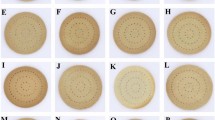Abstract
Potato flours prepared from three potato varieties, ‘OP-1’, ‘Kufri Sutlej’ and ‘Kufri Ashoka’, were used for biscuit preparation. Potato flours (fresh stored for six months at room and refrigerated temperatures) of each variety were incorporated in the traditional recipe to replace wheat flour at levels of 0, 10, 20, 30, 40 and 50 percent in preparation of biscuits. All the ingredients were constant except water and baking time which increased and decreased, respectively, with the increase in level of potato flour incorporation. Results of the sensory (appearance, color, flavor, texture, taste and overall acceptability) evaluation revealed that the ‘OP-1’ variety was rated higher for texture, taste and overall acceptability than the other two varieties. Biscuits prepared from the fresh flour rated better in color, texture and taste than the biscuits prepared from the flour stored at refrigerated temperature for six months. However, a declining trend in acceptability was observed with increasing level of potato flour for all the sensory characteristics. No significant difference was observed in acceptability of the product with substitution levels of 20% or less. The nutritional value of the biscuits (as determined through nutrient analysis-moisture, protein, fat and total starch) with the highest acceptable level of potato flour (fresh, variety ‘OP-1’, 20 percent), was similar to the control (wheat flour) biscuit.
Similar content being viewed by others
References
Talburt WF, Smith O (1975) Potato Processing, 3 rd edn, Connecticut: The AVI Publish-ing Company.
Grewal JS (1993) Potato growth and development in India. ‘souvenir’ Golden Jubilee (1942–1992) Symposium, Horticultural Research-Changing Scenario, pp 44–55.
Rao RN (1998) Potato – The versatile vegetable. Nutrition 32(4): 10–15.
Ezekiel R, Paul V, Singh J, Shekhawat GS (1999) Potato storage in India. Indian Farming 49(9): 21–25.
Kaldy MS (1972) Protein yield of various crops are related to protein value. Econ Botany 26: 142.
Sangwan SS (1991) Production and Marketing of Potato in India. New Delhi: Mittal Publication, pp 3–5, 44–55.
Chalom S, Elrezzi E, Pena P, Astiarsaran I, Bello J (1995) Composition of sulfited potatoes: Comparison with fresh and frozen potatoes. Plant Foods Hum Nutr 47(2): 133–138.
Shekhawat GS, Ezekiel R (1999) Potato: Potential as a staple food. In: The Hindu Survey of Indian Agriculture, pp 73–74.
Horton D, Sawyer RL (1985) The potato as a world food crop, with special reference to developing areas. In: Paul M Li (ed), Potato Physiology. London, pp 2–32.
CIP (1984) International Potato Centre. Potatoes for the Developing World. A Collabor-ative Experience. Lima: IPC, pp 12–14.
Gahlawat P, Sehgal S (1998) Protein and starch digestibilities and mineral availability of products developed from potato, soy and corn flour. Plant Foods Hum Nutr 52: 151–160.
Whitley PR (1970) Biscuit Manufacture. London: Applied Science Publishers Ltd.
Amerine MA, Pangborn RM, Roseller EB (1973) Principles of Sensory Evaluation of Food. New York and London: Academic Press.
AOAC (1975) Official Methods of Analysis, 112th edn. Washington, DC, USA: Association of Official Analytical Chemists.
Ranganna S (1994) Handbook of Analysis and Quality Control for Fruit and Vegetable Products, 2nd edn. New Delhi: Tata McGraw Hill Publishing Company Limited, pp 27–28, 125–126, 480–485.
Snedecor GW, Cochran WG (1967) Statistical Methods, 6th edn. Calcutta: Oxford and IBH Publishing Company.
Purves ER, Scrively CV (1975) Decreasing the retrograded starch level and increasing the rehydration rate of dehydrated potato granules U.S. Patent pp 866–917.
Author information
Authors and Affiliations
Rights and permissions
About this article
Cite this article
Misra, A., Kulshrestha, K. Potato flour incorporation in biscuit manufacture. Plant Foods Hum Nutr 58, 1–9 (2003). https://doi.org/10.1023/B:QUAL.0000040337.69812.cb
Issue Date:
DOI: https://doi.org/10.1023/B:QUAL.0000040337.69812.cb




